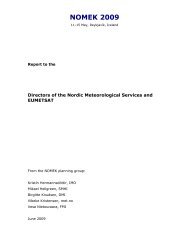International Symposium on Mitigative Measures against Snow ...
International Symposium on Mitigative Measures against Snow ...
International Symposium on Mitigative Measures against Snow ...
You also want an ePaper? Increase the reach of your titles
YUMPU automatically turns print PDFs into web optimized ePapers that Google loves.
<str<strong>on</strong>g>Internati<strong>on</strong>al</str<strong>on</strong>g> <str<strong>on</strong>g>Symposium</str<strong>on</strong>g> <strong>on</strong> <strong>Mitigative</strong> <strong>Measures</strong> <strong>against</strong> <strong>Snow</strong> Avalanches<br />
Egilsstaðir, Iceland, March 11–14, 2008<br />
within a certain area, in terms of avalanche and landslide safety. N<strong>on</strong>etheless, over the<br />
centuries, a number of farms have been destroyed by avalanches.<br />
The urbanisati<strong>on</strong> in Iceland has been more rapid than in most of the Western world. During<br />
the years 1880−1900 urbanisati<strong>on</strong> started for real al<strong>on</strong>g the seaside, prompted by the fishing<br />
industry.<br />
Before the 1920s, the <strong>on</strong>ly plans for the towns in Iceland were impromptu plans by occasi<strong>on</strong>al<br />
local governments. In most towns, no plan existed during the first decades of urbanisati<strong>on</strong>.<br />
Therefore, the spatial development of settlements at that time should reflect the view of the<br />
public towards snow avalanche and landslide risk to a greater degree than today. However,<br />
the landowners had a great influence <strong>on</strong> the development.<br />
So<strong>on</strong> after the towns started to form in Iceland, the first big avalanche accidents in urban areas<br />
occurred. In 1885, an avalanche killed 24 people in Seyðisfjörður. It is c<strong>on</strong>sidered that<br />
between 75 and 80 people were caught in the avalanche which damaged or destroyed around<br />
16 houses. In 1910, 20 people were killed in an avalanche in Hnífsdalur. Some houses,<br />
fisherman huts and sheds were destroyed. In 1919, an avalanche killed nine people and<br />
destroyed a herring factory, two houses and other buildings, in Siglufjörður. The avalanche<br />
occurred <strong>on</strong> the opposite side of the fjord from where the settlement is now and caused a<br />
tsunami that damaged boats at the harbour in the village.<br />
In general, it can be c<strong>on</strong>sidered that avalanche history <strong>on</strong>ly had a very temporary effect <strong>on</strong> the<br />
spatial development of towns during the first decades of urbanisati<strong>on</strong> in Iceland. Avalanches<br />
that caused death or major destructi<strong>on</strong> lived l<strong>on</strong>ger in the memories of people, or were taken<br />
more seriously than avalanches that caused <strong>on</strong>ly minor damage, and that is reflected in the<br />
spatial development. There are quite a few situati<strong>on</strong>s where areas within and close by the<br />
paths of large avalanches had become densely populated 10−20 years after the avalanche fell.<br />
The avalanche catastrophes in Seyðisfjörður, Hnífsdalur and Siglufjörður most likely had no<br />
effect <strong>on</strong> the populati<strong>on</strong> development of those towns in general. In fact, all of the towns had a<br />
major increase in populati<strong>on</strong> in the years after the accident, which was driven by booms in the<br />
fishing industry.<br />
THE EFFECT OF PLANNING<br />
The first planning laws were approved in 1921 and were valid for all towns and fishing<br />
villages with more than 500 inhabitants (Líndal, 1982). A planning commissi<strong>on</strong> was founded<br />
by the government. The commissi<strong>on</strong> hired specialists for the survey part, but the commissi<strong>on</strong><br />
itself was involved in most of the planning reports.<br />
The planning committee in many cases took natural hazards into account in their plans.<br />
According to the laws, it was obligatory to identify areas with avalanche hazard <strong>on</strong> the<br />
planning maps, however, no frame of reference was given. In practice, houses were not<br />
planned in areas where the commissi<strong>on</strong> knew about avalanches. It is not known how careful<br />
the commissi<strong>on</strong> was in obtaining historical records, but it is likely that it was mostly in the<br />
form of c<strong>on</strong>versati<strong>on</strong>s with local people. In some cases, the first plans were an attempt to<br />
move towns towards greater safety, especially where it was known that large avalanches had<br />
caused damage in the area. However, there has not always been an agreement between local<br />
governments and the commissi<strong>on</strong> <strong>on</strong> these matters.<br />
158 The effect of avalanches <strong>on</strong> the spatial development of settlements in Iceland











